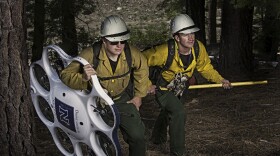A month after researchers conducted a cloud-seeding test using unmanned aircraft, a Reno-based drone company is building the next generation. As Reno Public Radio's Julia Ritchey reports, the project hopes to bring cloud seeding into the 21st century.
Inside the shop at Drone America, design engineer Kyle Pruett is showing off their plans for a new unmanned, fixed-wing aircraft called the Savant.
"So we have two prototype aircraft built," says Pruett. "I'm actually integrating the wiring for the autopilot and actuators right now... so that will hopefully go into flight test within the month."
Since 2011, the company has been designing, building and manufacturing drones in its Reno workshop. Their aircrafts are used for search and rescue operations, wildland and wildlife monitoring and, now, through a partnership with the Desert Research Institute, cloud seeding.
"What unmanned systems do is have the ability to potentially reduce costs and reduce risk," says Mike Richards, CEO of the company. "That's why we're teaming with Desert Research to enable us to expand the opportunities of seeding in more areas, particularly where drought is a factor. "
Several Western states have had cloud seeding projects in one form or another for decades, typically using ground generators or manned flights.
"At its most basic, we are equipping an unmanned aircraft with flares that burn and produce crystals of silver iodide," says Adam Watts, research professor at the DRI. "And it’s those crystals that we want to deliver to precisely the right location within the clouds that result in enhanced precipitation."
He says the use of drones could be a significant engineering breakthrough for the field.
Still, the practice has drawn scrutiny over how best to measure its actual impact. A few studies have estimated that the amount of extra precipitation produced by seeding to be between 5 and 15 percent.
Terry Deshler, a professor of atmospheric science at the University of Wyoming, conducted one of these studies, and even he admits the numbers may be too rosy.
"People want to be optimistic about the most positive result possible, but even the most positive result, that 15 percent, may be really, in terms of winter snow pack, may be 5 percent," he says. "[It] depends on various things."
Deshler says there may never be a way to measure the effect satisfactorily.
"My takeaway is that the same problems that plagued the science in the 1980s continue, and they're pretty well known problems. ...And so you can't have a controlled experiment where you can seed one cloud and then not seed that cloud and see what the effects are; nature doesn't give us that opportunity."
Beyond those limitations, there's also the challenge of funding. In times of drought, money tends to increase for cloud seeding, and vice versa.
The Desert Research Institute's latest program is being funded for two years through a state grant of $400,000.
Drone America's Kyle Pruett says now that they’ve proven they can deploy flares with their unmanned aircraft, the next test will be to fly one into an actual cloud during the right conditions.
"The Savant's a lot bigger challenge because we'll be flying non-line of sight in windy, icy conditions in the mountains, with burning flares on an aircraft that we can see," says Pruett. "No pressure."
Pruett says their task may be daunting, but could ultimately prove to be a more viable tool for coaxing water from the sky across the West.
**The Desert Research Institute is an underwriting sponsor of KUNR.






